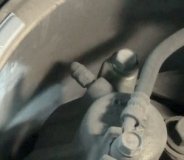If most of the line is not rusty, you can cut it at a clean spot where you have plenty of room, slide on a fitting, make a double flare, then use a union to connect the new piece of line. You have to look at which type of flare is used where it connects to the rubber flex hose. If it's the newer "ISO" flare, buy a pre-made line of the right length, and cut off the ISO flare and make a double flare where it will connect to that union. That can be a lot of work, and the original line may not take well to making a double flare. If one or two attempts don't give satisfactory results, or if you don't know how to make double flares, it's much easier to just buy one or two pre-made lines that total the right length, and replace it right up to the master cylinder. You can leave the old line in place, and use nylon tie straps to anchor the new line to it. When bending the new line, be careful to not kink it or let it sit too close to hot engine or exhaust parts.
This is going to take a while and the master cylinder is going to run empty. To prevent that and the long bleeding time it will require, place a stick between the brake pedal and seat to hold the pedal down about two inches. The brake fluid won't run past the lip seals in the master cylinder. When it comes time to bleed the new line, remove that stick, and loosen the cap on the master cylinder to prevent vacuum from building up in the reservoir. Leave the last fitting loose at the flex hose until fluid starts to run out. That may be sufficient and you won't have to worry about snapping off the bleeder screw on the caliper.
If you attempt to pedal-bleed the system with a helper, (which is not necessary), be certain to never push the brake pedal more than half way to the floor. At worst that can damage the master cylinder, and at least it will cause two of the four ports to become blocked. Unblocking them isn't a serious procedure but it is time-consuming. It's just easier to avoid that.
Wednesday, December 12th, 2012 AT 11:36 PM


